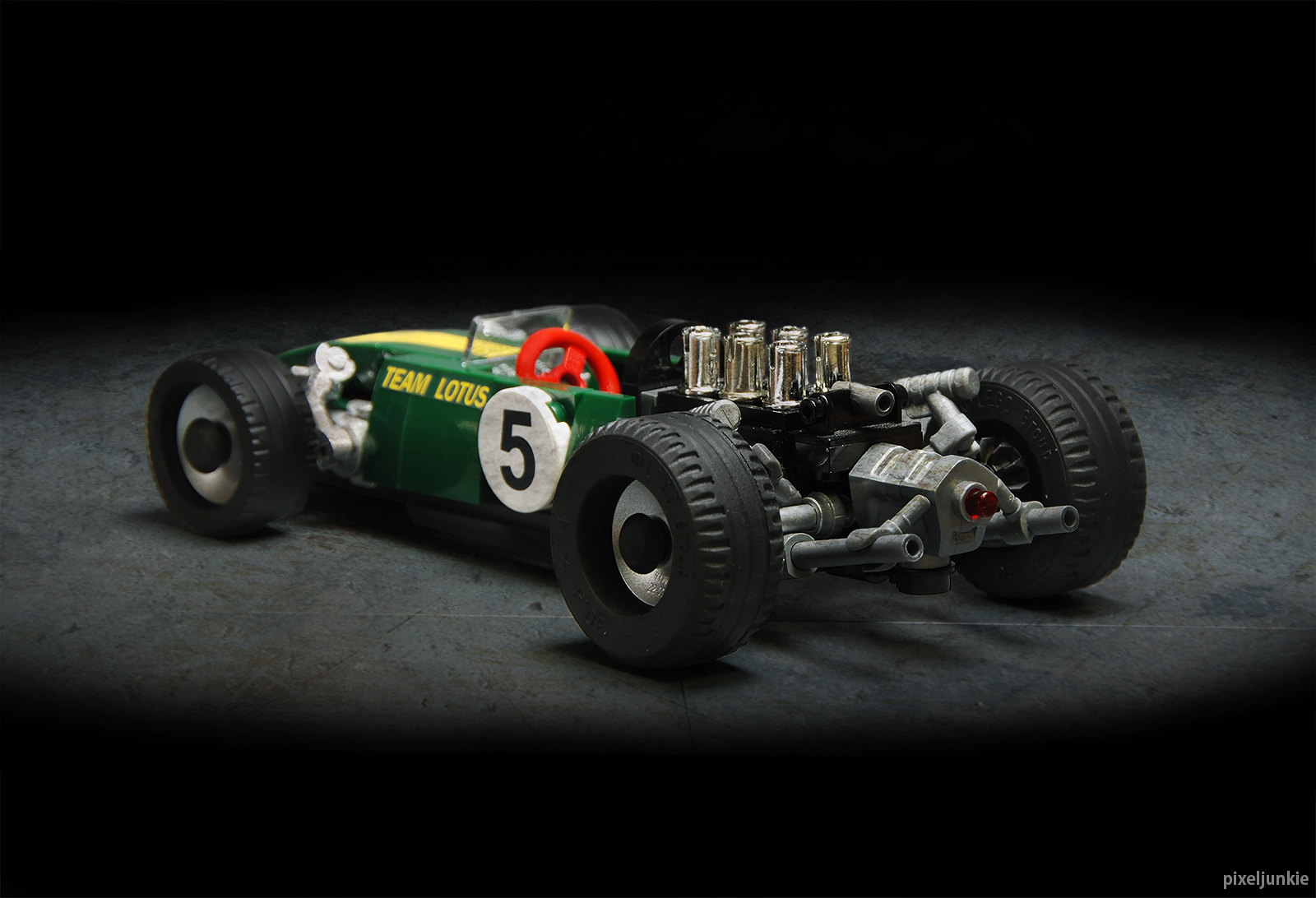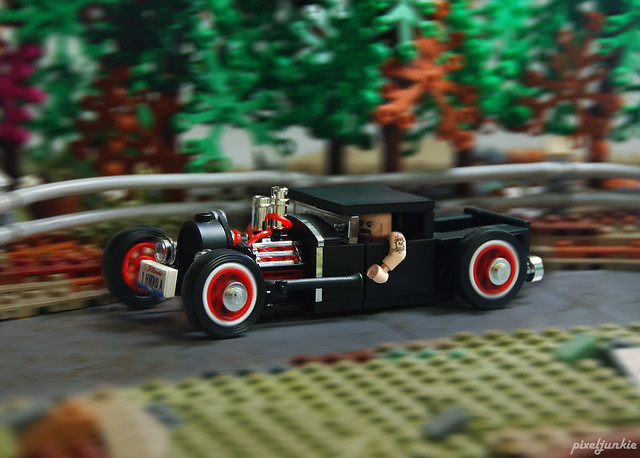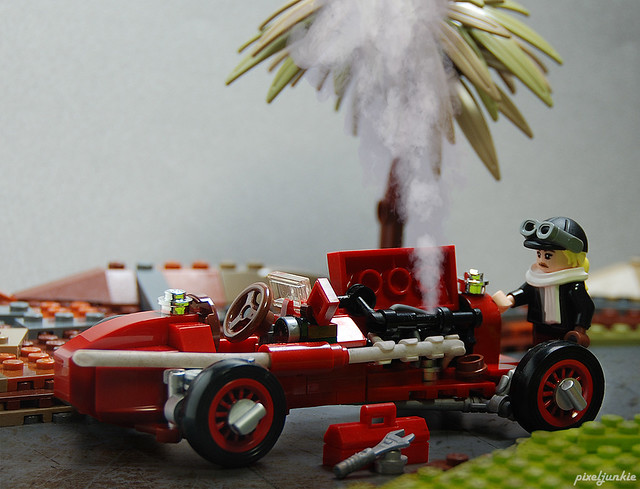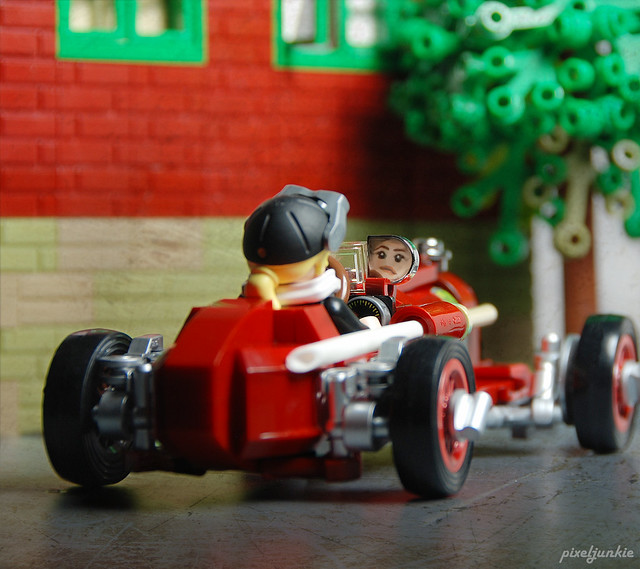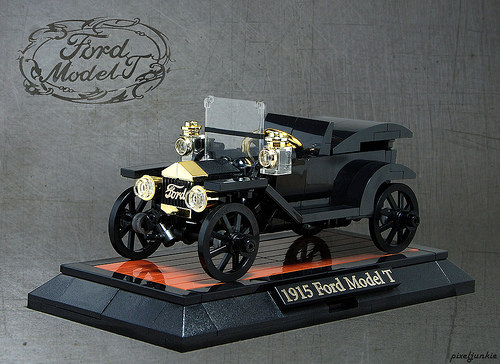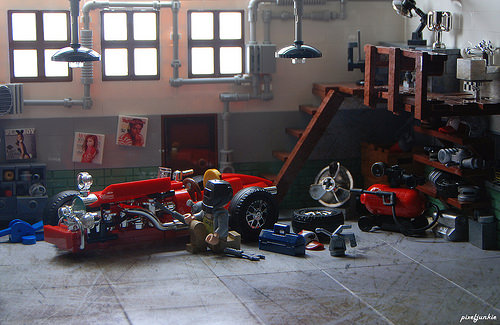LEGO’s Speed Champions line has done a pretty good job of covering cars from a diverse range of eras, but they’re yet to represent the really early days of the automobile. In truth it’s unlikely they ever will, but thankfully we have builders like Pixeljunkie to scratch that particular itch! Pixeljunkie is no stranger to vintage automotive builds, and his latest creation is a doozy all the way from 1905. The car in question is the Laurin & Klement (L&K) company’s first motor car, the Voiturette A, which is where the firm now known as Skoda can trace its origins to. The company originally made bicycles, which makes the use of bicycle wheels for the car’s spindly wheels rather appropriate! Nougat and .dark red pieces are good approximations of the wooden body. The lamp on the right hand side of the car is worthy of further inspection, as well. It’s very simple: two gold chrome pieces, including the One Ring, on a headlight brick. The fact this headlight brick is transparent, though, makes the gold pieces stand out, and makes the lamp seem smaller and daintier than if a solid colour had been used. Finally, take note of the umbrella used as detailing on the footplate… There’s no roof on this puppy, so if it rains, you may need it!
Tag Archives: Pixeljunkie
“Looks like my hideout’s not so hidden anymore...”
Check out this excellent LEGO microscale cove built by Flickr user Pixeljunkie. The heavy use of slopes laid upon their sides provides an organic, rocky backdrop for a tiny beach scene. But it’s not just any beach! This is the hideout of Porco Rosso, the Italian flying ace slash anthropomorphic pig from the Studio Ghibli film of the same name. You can see his iconic red plane, a Savoia S.21, sitting in the water. On the coast are his tent, chair, and radio, where Porco would relax between bouts with the sky pirates of the Adriatic. The shaping of the plane in such few bricks is inspired, and immediately recognizable to someone familiar with the movie. Also of note, the 1×1 plate with tooth used as a dock is some great parts usage at this scale.
A real Mini-ature marvel
As the owner of a classic Mini, any LEGO model of the world’s favourite small car (shush, VW Beetle fans!) is likely to pique my interest. So how do you top that? Well, as pixeljunkie demonstrates, you build the Mini’s revolutionary interior as well!
 This exploded view actually reminds me of a cutaway Mini that currently resides in the London Science Museum, originally made for the Mini’s launch in 1959. Much of the promotional material for the Mini focussed on the tiny size that its innovative packaging allowed, and that pixeljunkie shows off so well here. The construction is faithful to the real car: front and rear subframes, seating with floor pan, and the bodyshell. And of course, a superbly detailed A-series engine in the front!
This exploded view actually reminds me of a cutaway Mini that currently resides in the London Science Museum, originally made for the Mini’s launch in 1959. Much of the promotional material for the Mini focussed on the tiny size that its innovative packaging allowed, and that pixeljunkie shows off so well here. The construction is faithful to the real car: front and rear subframes, seating with floor pan, and the bodyshell. And of course, a superbly detailed A-series engine in the front! 
Much like the real thing, it’s amazing how much you can squeeze into such a small space!
Sew cute and functional!
Alright, alright! I know it’s a pun only a dad could love, but I can’t help myself. This adorable little LEGO sewing machine, built by Vaionaut, is both clever and crafty. I’m a fan of the dress slopes used to make the body look sleek. I also like the Fencer’s foil used as the needle.
Of course, what would an old-fashioned sewing machine be without its mechanics? I’m a sucker for moving parts. The function is pretty simple, but it sure does make it look cool!
If you think this little guy looks familiar, maybe that’s because another builder came up with a sewing machine very similar a while back. It also moves! And in fact, that builder, Pixeljunkie, has updated his machine with some shiny new bling.
Click to see the updated Singer Sewing Machine
Built for speed and set the standard
1967 was the year Formula 1 changed forever, as the birth of the Lotus 49 set the bar not only as the car to beat, but also to replicate. Fifty-two years on, Pixeljunkie has presented us with a gorgeous homage to this feat of engineering mastery. Sporting the classic colour scheme and markings of driver Jim Clark, this brick rendition has some stunning custom chrome pins as well as some nicely employed stickers to really bring the realism to the fore. Working within the Minifig scale can be an obscure challenge that restricts an amount of detail. I feel Pixeljunkie has made some excellent compromises without straying too far from the source material.
Looking at the rear of this beautiful build, we find a minifig hammer head used ingeniously as the gearbox. I’m not sure another piece could have been used so well in this application. I’m also a massive fan of the many uses builders find for the rubber tread attachments. Using them as wheel hubs on top those metallic silver dish rims, has really captured the era well.
If this open-wheel beast inspires you, check out another of Pixeljunkie’s classic race machines, the Alfa Romeo P3.
Hey pal, where ya going?
Next to towering skyscrapers and the Statue of Liberty, New York City has also long been identified with streets full of yellow taxicabs. LEGO car builder Pixeljunkie chose to represent a classic Checker cab, complete with its characteristic black and white checkerboard-style trim. While the car itself looks great, it is further enhanced by the gritty scenery which includes a knocked over trash can. Meanwhile, the irritated-looking minifig driver sitting cross-legged adds an extra dash of personality.
If you love the Checker cab, you will probably also enjoy Pixeljunkie’s chopped Model A Ford hot rod. It packs some serious muscle in the engine and behind the wheel, and the whitewall tires give it a strong sense of style.
The little red Alfa that could
Back in the 1930s, Enzo Ferrari teamed up with automobile manufacturer Alfa Romeo to make history on the racetrack. Ferrari wasn’t in the business of making cars yet, but their famous prancing pony emblem was used on team Ferrari cars. One of the most famous team Ferrari Alfas was a 1934 P3, which won the 1935 German Grand Prix with Tazio Nuvolari behind the wheel. Thanks to Pixeljunkie, Team Ferrari’s P3 has been brought back to life in LEGO-form. There is some excellent visual storytelling here, with an intrepid female driver making a pit stop in the woods to admire local wildlife. Both the car and surrounding landscaping look beautiful.
Like many of his other cars, Pixeljunkie places the Alfa in different scenarios. Here, we get a look under the hood at the expense of some engine trouble. Fortunately, the driver remembered to bring along her toolkit.
I particularly enjoy this playful image, which shows the driver’s reflection in the car’s rear view mirror. With the engine fixed, she’s ready to hit the road again!
The Alfa Romeo P3 is just one in a growing number of cars built by Pixeljunkie and featured on the Brothers Brick, including a Ford Model T, Mercedes Benz W196, and Type 37A Bugatti.
F is for Ford fitted with a fantastic folding top
Pixeljunkie continues to delight with his series of LEGO cars. This time, he turned to the Brass Era with a tiny 1915 Ford Model T roadster pickup. The Model T was the car that made driving more accessible to the general public, and Pixeljunkie’s model is a sharp-looking replica that conceals an amazing feature.
The thing that makes his car especially impressive is the incorporation of a working folding top. A stop-motion video showcases how smooth this feature is.
Just like his 1955 Chevrolet Bel Air, Pixeljunkie documents his Model T as if it were a restoration. Over the past few weeks, he has teased us with images leading up to the finished product. It all started with this group of mechanics carefully looking over a set of plans. Look carefully, and you’ll notice the one minifigure has a Ford tattoo on his arm. You might say it is a “FORDshadowing” of things to come!
Click to see the amazing photos documenting this car’s build in a brick-built mechanic’s shop
From parts car to restored racing legend, this garage has it all.
Over the past few weeks, I have been following Pixeljunkie’s progress on an exciting series of photographs that seemingly depict the restoration of a classic 1950s Mercedes race car. Time and time again, Pixeljunkie has demonstrated an impeccable talent in building minifigure-scale vehicles and setting the scene (like his Bugatti we featured back in July). His latest image depicts a gritty but gorgeous-looking garage, along with his partially stripped down Mercedes race car. Pixeljunkie opted to leave the engine exposed, and it sports a fair amount of detail for being confined within such a small space.
With the extensive repairs out of the way, it’s time to load the car up for transport. The fully restored racer looks simply stunning, and the small team of restorers is just as charming as the car itself. Out of the entire lot, the middle-aged motorhead with cigarette in hand is my favorite (the cigarette itself is an interesting use of three Nanoblock pieces). Several other fun details can be found in Pixeljunkie’s garage, such as a loft area with a drafting table and sink. Meanwhile, shelves are filled with a wide variety of tiny tools.
See the vintage Mercedes racing car in its restored glory
Speed through the turns in this beautiful Bugatti
Pixeljunkie is back on the scene, turning once again to the pages of automotive history. You might remember us sharing his 1955 Buick squad car and luxurious 1930s convertible. This time, he brings us a French racing legend in the form of the 1928 Bugatti Type 37A. Back then the competition for consumers was fierce, and touting a car’s racing performance was used as a means of advertising. We have to give Pixeljunkie the Golden Cup for this one because it is every bit as epic as the car it is based on. The lovely blue and white color scheme, the shiny trim, the little windshield…I love it all.
Despite his ongoing thirst for speed, Pixeljunkie has since taken time out of his schedule to recreate a scene from the 1929 Monaco Grand Prix. There’s even a cameraman ready to photograph the fantastic finish!
Now that you are caught up on Bugatti’s heritage, what not race on over to our review of the cutting-edge Chiron?





